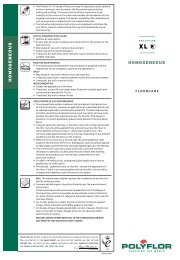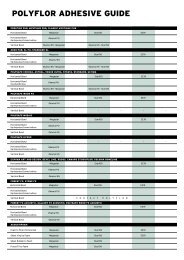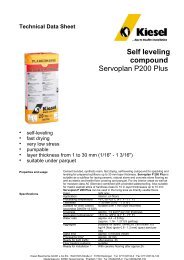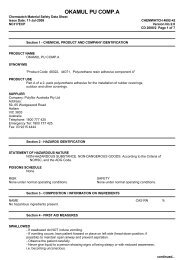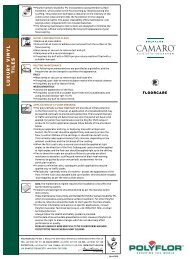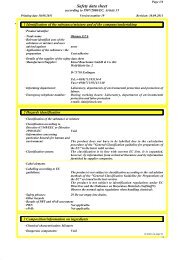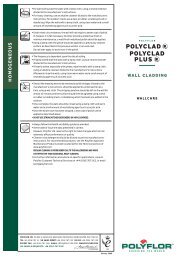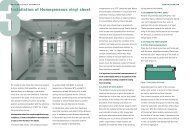Installation of ESD Floorcoverings - Polyflor
Installation of ESD Floorcoverings - Polyflor
Installation of ESD Floorcoverings - Polyflor
You also want an ePaper? Increase the reach of your titles
YUMPU automatically turns print PDFs into web optimized ePapers that Google loves.
system can be brass, copper or stainless steel<br />
and should be nominally 50mm wide and 0.1mm<br />
thick. However, the width is only important for<br />
the “Conductive” floorcovering.<br />
When an earthing system is installed, <strong>Polyflor</strong><br />
recommends the use <strong>of</strong> at least two connections<br />
to earth, the second as a security back-up<br />
should the first be disconnected or damaged.<br />
Connection <strong>of</strong> the earthing system to the<br />
building earth is normally carried out by a<br />
qualified electrician and not the flooring<br />
contractor.<br />
8.4.1 <strong>Polyflor</strong> Static Dissipative (SD)<br />
<strong>Floorcoverings</strong><br />
The earth strip is laid 150mm from one side <strong>of</strong><br />
the room, in the same direction as the vinyl<br />
sheets are to be laid. This strip is connected to<br />
a known earth (Figure 22).<br />
Figure 22 Earthing strip layout<br />
A second strip is laid at 90º to the first, 150mm<br />
from the edge and running across the full width<br />
<strong>of</strong> the room. Further strips are laid at 20 metre<br />
intervals as determined by the size <strong>of</strong> the room.<br />
8.4.2 <strong>Polyflor</strong> Electrostatic Conductive (EC)<br />
<strong>Floorcoverings</strong><br />
A length <strong>of</strong> earth strip is adhered to the<br />
isolating underlayment and connected to a<br />
known earth. The strip need only extend along<br />
the floor for 150mm (Figure 23).<br />
Figure 23 Earth connection<br />
8.4.3 <strong>Polyflor</strong> Conductive <strong>Floorcoverings</strong><br />
With this type <strong>of</strong> flooring, an earthing grid <strong>of</strong><br />
the correct size strip (50mm wide, 0.1mm thick)<br />
is essential. The strips should be laid to form<br />
600mm2 grids across the floor, the perimeter<br />
strips being 150mm from the wall (Figure 24).<br />
At an appropriate point the strip should be<br />
connected to a known earth. It is important that<br />
the layout <strong>of</strong> the grid is confirmed with the end<br />
user as there are variations in the requirement<br />
for some military specifications.<br />
Figure 24 Earthing strip layout<br />
8.5 INSTALLATION METHODS<br />
The basic techniques for installation <strong>of</strong> <strong>Polyflor</strong><br />
<strong>ESD</strong> floorcoverings are the same as described<br />
for standard vinyl sheet and tile in Sections 3<br />
and 4 respectively. However, there are a<br />
number <strong>of</strong> important differences:<br />
8.5.1 <strong>ESD</strong> Vinyl Sheet<br />
<strong>Polyflor</strong> <strong>ESD</strong> vinyl sheet should be installed by<br />
the double drop method. This is because the<br />
conductive adhesive contains carbon, which<br />
results in low tack.<br />
Once the adhesive has been spread, the vinyl<br />
sheet is laid into it and pressed all over to<br />
ensure an even transfer <strong>of</strong> adhesive. The vinyl<br />
sheet is then folded back and left until the<br />
adhesive becomes tacky. When the adhesive is<br />
tacky, the vinyl sheet should be accurately<br />
re-laid, ensuring it does not twist or trap air<br />
bubbles. Seams must be without gaps and any<br />
excess adhesive should be removed as work<br />
proceeds. The vinyl sheet is then rolled with a<br />
68kg articulated floor roller in the short<br />
direction fırst, then the long, and the rolling<br />
repeated between one and four hours later.<br />
8.5.2 <strong>ESD</strong> Vinyl Tiles<br />
<strong>Polyflor</strong> <strong>ESD</strong> vinyl tiles are installed by the<br />
same method as standard vinyl tiles – the single<br />
stick method. The grid layout for static control<br />
tiles is the same as for sheet vinyl, as described<br />
previously.<br />
Note: <strong>ESD</strong> vinyl tiles must always be heat<br />
welded. See Section 11.<br />
8.6 SPECIAL PRECAUTIONS<br />
Special precautions must be taken with the<br />
following products:<br />
8.6.1 Electrostatic Conductive (EC)<br />
<strong>Floorcoverings</strong><br />
Pipes or metal projections (e.g. metal gullies,<br />
door spring plates etc.) must be insulated from<br />
the EC floorcovering and free from conductive<br />
adhesive. The following method <strong>of</strong> installation<br />
is recommended.<br />
The EC floorcovering should be cut 50mm<br />
short <strong>of</strong> any pipe or metal fixture. This infill<br />
area should be laid with a suitably coloured<br />
standard <strong>Polyflor</strong> sheet vinyl, adhered with a<br />
non-conductive adhesive. This infill piece<br />
should then be welded to the <strong>ESD</strong> floorcovering<br />
with a standard weld rod.<br />
8.6.2 Conductive Floorcovering<br />
<strong>Polyflor</strong> Conductive does not provide<br />
protection from a short circuit on a 240/250<br />
volt mains. Where this material is installed, all<br />
electrical equipment and switches must be<br />
located outside the building. No portable<br />
electrical tools should be used inside, unless<br />
earth leakage circuit breakers are fitted to the<br />
switchgear.<br />
8.7 HEAT WELDING<br />
All <strong>Polyflor</strong> <strong>ESD</strong> floorcovering installations<br />
(excluding access panels) must be heat welded.<br />
Ideally, the floor should be left for a minimum<br />
<strong>of</strong> 24 hours before welding the joints. This will<br />
prevent adhesive bubbling up into the seams<br />
when heat is applied. For details <strong>of</strong> heat<br />
welding, see Section 11.<br />
Note: Conductive welding rod is not a<br />
requirement with <strong>Polyflor</strong> <strong>ESD</strong> floorcoverings.<br />
8.8 TEST METHODS<br />
Worldwide, there are a great many test methods<br />
for electrical grade floorcoverings and, with<br />
rapid developments in the electrical and<br />
electronic industries, standards are constantly<br />
being reviewed. To ensure that the floor is<br />
tested to the latest specification, it is suggested<br />
that the architect or specifier should obtain a<br />
copy <strong>of</strong> the test method and requirements from<br />
the local <strong>of</strong>fice <strong>of</strong> the National Standards<br />
Authority. It should then be attached to the<br />
specification prior to the ordering <strong>of</strong> materials<br />
and installation <strong>of</strong> the floor. If a test method is<br />
not specified, the following procedure is




